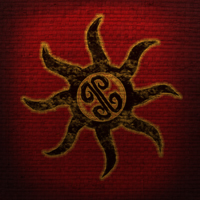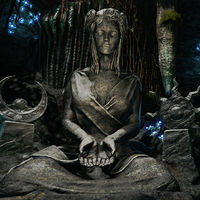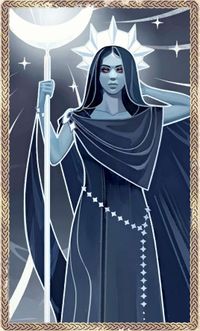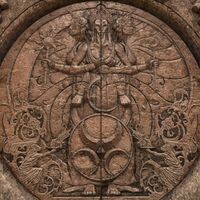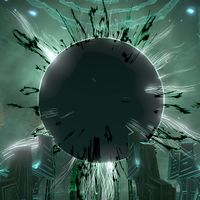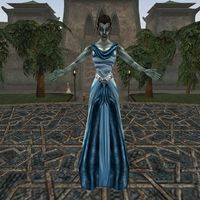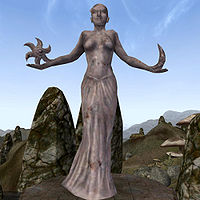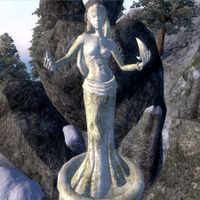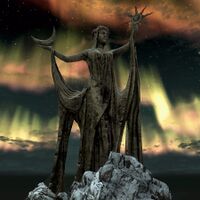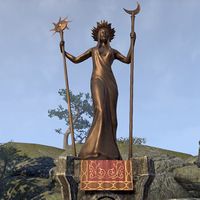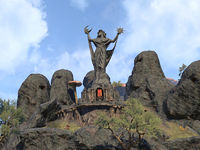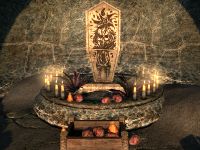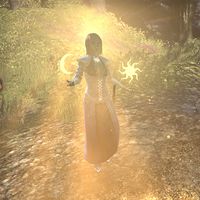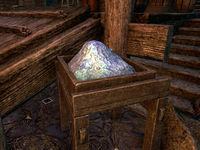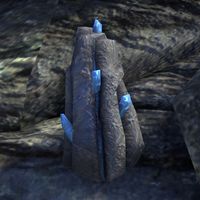Lore:Azura
| To meet our site's higher standard of quality, this article or section may require cleanup. The user who placed this here had the following concern: Article is missing significant amount of Dunmeri lore To leave a message about the cleanup for this article, please add it to this article's talk page. |
- "Molag Bal wanted my mind, Boethiah wanted my arms, and Nocturnal perhaps my curiosity. Azura wants all of that, and our love above all. Not our abject slavering, but our honest and genuine caring in all its forms. It is important to her that our emotions be engaged in her worship. And our love must also be directed inward. If we love her and hate ourselves, she feels our pain. I will, for all time, have no other mistress." —Sigillah Parate, Invocation of Azura
Azura of the Crimson Gate,[1] also known as: Queen of Dawn and Dusk,[2] the Mother Soul,[3] Moonshadow, Mother of the Rose, Queen of the Night Sky,[4] Twilight Queen,[5] the Rim of all Holes,[6] the Cosmic Severer,[7] and called Azurah by the Khajiit,[8][9] is a Daedric Prince whose sphere is dawn and dusk—the magic in-between realms of twilight[4]—as well as mystery and magic, fate and prophecy,[3] and vanity and egotism.[1] Azura is one of the few Daedra who maintains the appearance of being "good" by mortal standards, and reportedly feels more concern for the well-being of her mortal subjects than other Daedric Princes. It is said she wants their love above all else, and for her worshippers to love themselves; it pains her when they do not. This attitude leads to an extremely devoted following.[10] She is also one of the few Princes who constantly maintains a female image, and is perceived accordingly.[3] In Khajiiti creation myths, Azurah is credited with introducing moon sugar to Khajiit,[8] and this belief is also told within tales aimed at Khajiiti children.[11]
The Five Songs of King Wulfharth claims that Alandro Sul is the immortal son of Azura.[12] While Azura is considered one of the "good" Daedra by the Dunmer of Morrowind,[3] elsewhere she has been known to be allied with Molag Bal,[13] who is known to the Dunmer as one of the Four Corners of the House of Troubles.[14] The people of the Iliac Bay region believe that Azura bewitches some of her followers to become her "lovers" and "virtual slaves".[1] Her followers acknowledge that she is "cruel but wise".[10]
In addition to being one of her many sobriquets, "Moonshadow" is also the name of Azura's realm in Oblivion. Azura's Star, the Twilight Star, is visible at dawn and dusk low on the horizon below the constellation of the Steed.[3] Her summoning day is Hogithum, a festival on the 21st of First Seed.[10]
Worship[edit]
Worshippers of Azura are known as Azurites.[UOL 1] Those that swear complete fealty to her may be granted fiery azure eyes,[UOL 1] a characteristic that is also present on people that return from her realm Moonshadow.[15] Azurite is also the name of a rare, blue mineral found within the northern hills of Bangkorai.[16] It has connections with Azura; the Spirit Wardens are known to carve decorative items from it[17] and use it to cleanse her shrines.[18] Daedra worshipers claim they speak to Azura through silvered crescent mirrors.[19] Azura's shrine in Cyrodiil is located high in the Jerall Mountains, far north of Cheydinhal and east of Sedor.[20] Her shrine in Skyrim is high on the peaks of Winterhold, south of the capital city and southeast of Saarthal.[21]
Anticipation and Reclamation[edit]
The Dunmer of Morrowind believe that Azura is their god-ancestor, who taught the Chimer how to be different from the Altmer (though some of her teachings are occasionally attributed to Boethiah).[9] These tales often portray her as more of a communal progenitor[3] or "cosmic force" for the Chimer rather than an ancestor or a god.[9] They refer to her as The Twilight,[22] Lady of Twilight, Goddess of Twilight,[23] Goddess of Dusk and Dawn[3] (or Dawn and Dusk), and Mother of Roses.[22]
Several legends hold that Lord Nerevar was Azura's champion, and the two had a special relationship. He consulted Azura on important matters, and it was she who blessed his ring Moon-and-Star, a unique ring made by Dwemeri smiths before the First Council was formed, so that it would kill any who wore it except Nerevar. It was on this ring that Nerevar swore to the Ashlander tribes that he would always honor their way of life, and thus earned their allegiance.[24] The ring also gave him great powers of persuasion.[25]
The Heirographa, the orthodox teachings of the Tribunal Temple, held that Nerevar, with the help of Azura and the Tribunal, utilized the Heart of Lorkhan to make the Dwemer disappear.[26][27] Some Ashlander accounts corroborate that Nerevar and Azura made the Dwemer disappear,[26] but generally hold that the Dwemer destroyed themselves.[27]
At some time soon after the climax of the battle of Red Mountain, following the disappearance of the Dwemer, Nerevar insisted that he, Almalexia, Sotha Sil, and Vivec swear upon and before Azura never to employ the Tools of Kagrenac in the profane manner that the Dwemer had intended. A few years after the battle, when the Tribunal broke their oath to Nerevar and used Kagrenac's Tools to seize divine power, Azura appeared and cursed them. She assured them that her champion Nerevar would return to punish them for their perfidy, and to make sure such profane knowledge might never again be used to mock and defy the will of the gods. When Sotha Sil dismissed her claims, all Chimer were changed into Dunmer, and she professed that all the Dunmer would share the fate of the Tribunal until the end of time.[28]
After the apotheosis of the Almsivi in the First Era, Azura was recognized as one of three "Good Daedra" who swore allegiance to the new gods. The Temple dubbed these three the Anticipations, as they were "the early ancestral anticipations of the loving patronage of the Tribunal".[3] Azura became the Anticipation of Sotha Sil, female to his male.[3][9] However, Azura and the other Good Daedra (Boethiah and Mephala) continued to be venerated by the nomadic Ashlanders.[29]
Azura sees into the Twilight of the future, and guides her followers through it. Those who were faithful to Azura were given a vision that led them away from the island of Vvardenfell before calamity struck,[22] which was soon set in motion after 4E 5, the Red Year. A massive eruption of Red Mountain wiped out much of Vvardenfell and devastated the mainland as well.[29][30] This, combined with the apparent disappearance of the three Tribunes at the end of the Third Era[31][32] caused a schism in the Temple, which ultimately resulted in the (former) Dissident Priests seizing control.[29] The "New Temple" that arose from this declared worship of the Tribunes a "result of misguided teaching". It also declared the triad of Azura, Boethiah, and Mephala to be the "true way". Thus, having reclaimed their status, they are now worshipped in Morrowind as the Reclamations.[29]
The Lepidopterans, a sect of Azura worshippers, wear intricate butterfly masks to hide their identities. By 2E 582, these masks had become a popular trend among the disillusioned youth of mainland Morrowind.[33]
Azurah[edit]
In Elsweyr, Azura is a somewhat distinct entity, the goddess Azurah, the Mother of All Khajiit,[34] She Who Sits at the Precipice[35] and the Favored Daughter of Fadomai.[8][9][36] Azurah carries the burdens of the Khajiit's ancestors; her spheres are Magic, Beauty, and Prophecy, and she is the "keeper of all gates and keys, all rims and thresholds".[34] The goddess is credited with making the Khajiit out of the "forest people" (some of whom became the Bosmer) living on Nirn[8] and binding them to the Lunar Lattice, (or Ja-Kha'jay) [34] though other sources say the Khajiit were made out of "Altmeri stock".[9] It is said that Azurah knows the names of all the Khajiit that will ever live, and knowing her is the first step on their Path.[34] Azurah's is the "twilight path" to love and redemption. The Khajiit believe Azurah oversees the Gates of the Crossing behind the Lunar Lattice, a twilight realm between death and the afterlife.[37] One religious text refers to Azura as the Ur-dra, alongside Namiira.[36]
Azurah contains three forms, known as Phases, the Khajiit, Mer and Human form.[38] She is said to be more beautiful than any other spirit, save for her sister, Nirni. She killed the dark spirit Varmiina in the underworld, which is why Varmiina haunts the dreams of the Khajiit.[39] Some say she often walks the halls of Hermorah's library, sharing in his knowledge.[40] Khenarthi is Azurah's messenger, and ferries the dead Khajiiti souls to her for judgment. Azurah tends the lanterns lit by Khenarthi in the eyes of Jone and Jode, their stillborn brothers, when they burn low.[34]
Following the rise of the Riddle'Thar she fell in prominence somewhat,[41] and is seen as as a "distant mother."[42]
A Khajiiti story describes her Khajiiti form as lithe, with eyes that shined like the moons, and wearing a silken dress of purple and gold when clothed.[35]
Mythology[edit]
Khajiit Myth[edit]
Azurah was born from the third litter of Ahnurr and Fadomai, after the twin Moons and their Motions, and Nirni. Nirni and Azurah immediately began fighting for their mother's favor, but soon an angry Ahnurr struck Fadomai, and she fled into the Great Darkness with her children for protection. There, a dying Fadomai birthed her youngest, Lorkhaj, and bestowed gifts upon the rest. One by one the children received their gifts and departed, until only Azurah and her mother remained. Fadomai then left Azurah her greatest gift, three secrets—instructions on how to create the Khajiit.[8]
Much of what comes after are known in pre-ri'Datta Khajiiti stories. They state that Azurah wept as her dying mother told stories of love, war, and undreamed dreams; the names of all gates and thresholds, of all the spirits, and of all the Khajiit that would ever live. Azurah wept so much that the moonlight reflecting off her tears "became one with the Lattice" as Fadomai died. Azura remained within the Great Darkness for some time, consumed by her grief.[36]
Azurah and Lorkhaj[edit]
Sometime later, Nirni needed a place to bear children. Lorkhaj tricked his siblings into creating the World to satisfy her desire, and many of Fadomai's children died in its creation. The survivors killed Lorkhaj[34] and tore out his heart.[8] Or so they believed, for the Great Darkness in his blood filled the hole where his heart had been.[36] He sought out Azurah for help.[39] Meanwhile, Azurah remained within the Great Darkness, mourning Fadomai's death. In time, the light from her tears and the Lunar Lattice dispersed the darkness, and she found herself in a "place of moonlight and shadow". Azurah then tried to return to her mother's side, but her tears had created a great sea, and beyond it stood a black gate that opened into darkness.[36] And there stood Lorkhaj, his chest gaping, a shadowy imitation of his heart beating steadily, dripping black blood. But Azurah knew the names of all of the spirits, so she recognized the Great Darkness for what it was.[36] Azurah was able to rip the Dark Heart—and all the Darkness—out of her brother before it could consume him.[36][39] She cast it beyond the sea, into the Void, where it became the Moon Beast, the first of the dro-m'Athra,[36][39] and Lorkhaj perished within Azurah's embrace. Azurah made a funeral pyre for her brother before the gate, and lit it with the Twin Lanterns of Jone and Jode.[34][36] Her tears fell upon the pyre and the ashes scattered across the Lattice.[36] As a result, it is said Azurah (and Khenarthi) can call upon the "true spirit" of Lorkhaj to appear.[34]
The spirit Noctra was born from the black blood of Lorkhaj at the steps of the Void Gate. Boethra was able to defeat the spirit and took her to Azurah for judgment. Azurah was merciful, and allowed Noctra to live if she agreed to serve Azurah and the Lunar Lattice. But Noctra stole one of Azurah's keys and fled into the Void. So Azurah summoned the true spirit of Lorkhaj after her, and now Noctra aids the Khajiit when she is called upon.[39]
It is also said that an unnamed "spirit of vengeance" was born from Azurah's grief after the deaths of her mother and brother. It has no will of its own, and can only be summoned by Azurah, Boethra, and Mafala, or by those who know its true name. Tales describe its appearance as a black panther, a warrior in ebony armor, or a hidden sword.[39]
The Khajiit[edit]
Because of Lorkhaj, Nirni could now make children. But she was sad because the forest people, her favorites, were "torn between man and beast" and did not know their shape. So Azurah came to Nirni and tricked her into allowing the creation of the Khajiit, offering a "gift" of new people. She spoke Fadomai's First Secret, and the Moons parted for her. She took some of the forest people and made them many shapes, for every purpose, called them the Khajiit, and put them in the best forests and deserts on Nirni. Azura told them the Second Secret and made them Nirni's secret defenders, and bound them to the Lunar Lattice. And she spoke the Third Secret, and "the Moons shone down on the marshes and their light became sugar".[8]
However, Y'ffer overheard Azurah speak the First Secret and told Nirni what Azurah had done. So Nirni made the lands of the Khajiit inhospitable, and allowed Y'ffer to change the forest people into elves—the Bosmer. And Y'ffer shouted the First Secret across the heavens so all the original spirits could cross the Lattice, but Azurah ensured that neither Ahnurr nor Lorkhaj could hear the Secret.[8] Y'ffer was corrupted by the Namiira sometime after Lorkhaj's death, and murdered Nirni. Hircine, Azurah and Khenarthi slew him in retaliation for the deed, then built a cairn for Nirni using his bones.[40]
Sometime before the Khajiiti people's "first memory", Azurah, knowing that the false Lorkhaj, the Moon Beast, would one day covet her children, used the Twin Lanterns to summon Lorkhaj's true spirit[34] to be a sky-guardian.[43] As the third moon, Lorkhaj shined his light upon the Khajiit, choosing the purest of heart to be part of the "Litter of the Hidden Moon", to learn the way of the Moonlight Blade.[43] And from then on, on nights of the Ghost Moon, Azurah opens the Void Gate, and the Moon Beast will challenge mortals until banished.[39] Modern Khajiit have fallen away from this belief, instead interpreting the Ghost Moon as the corpse of Lorkhaj which was flung to the moons after Convention, and forced to follow Jone and Jode forever as punishment.[44][45]
Magrus' Eye[edit]
It is said that Magrus serves as a reminder of Azurah's wrath.[34] The Sun God once fought Boethra and Lorkhaj, and Boethra plucked out one of his eyes.[34][46] Half-blinded, Magrus fell into the Moonshadow, where Azurah judged him too fearful to rule a sphere, and tore out his other eye (though other stories say he gave Azurah the eye willingly). Azurah took the eye and fashioned it into the Aether Prism, a stone that reflects the Varliance Gate, and opens from Dawn to Dusk.[34]
The Mermaid of Anvil[edit]
The Mermaid of Anvil is a statue of mysterious origin. The statue of a beautiful, half-fish half-woman seems to be older than the city of Anvil itself. Due to the impressive scale and grandeur of the statue, many theorize it depicts some sort of forgotten god or an unrecognized aspect of one of the Divines. Some scandalizing but notable rumors claim that the statue depicts Azura as she appeared to some ancient sea-dwelling civilization. However, what is known of extant aquatic races like the Sload and Dreugh casts doubt on this idea, as races such as them are not known for creating works of such beauty.[47]
History[edit]
First Era[edit]
Many years after the Alessian Slave Rebellion, tensions between the descendants of enslaved Nedes and remaining Ayleids grew. Culanwe, one of the most beloved servants of Azura, sought to broker peace between the Nedes and the Ayleids. An Ayleid messenger was mysteriously murdered during this, causing suspicions between the two forces to grow, until an outsider Nede and Ayleid discovered that a servant of Molag Bal was responsible, seeking to sabotage Azura's will. United against a common foe, the Ayleids and Nedes made peace, though Culanwe sought to stop Molag Bal's plots for good.[48] She would later be captured at Laeloria and imprisoned in Coldharbour, tortured by Molag Bal for millennia, much to Azura's dismay.[49]
The disaster caused by Molag Bal at Gil-Var-Delle was the catalyst that sparked the conception of the Coldharbour Compact between the 3rd and 5th of Rain's Hand, 1E 2920.[50] It was an agreement between Tribunal god Sotha Sil and eight powerful Daedric Princes: Azura, Boethia, Hermaeus Mora, Hircine, Malacath, Mehrunes Dagon, Molag Bal, and Sheogorath. Little is known about the Compact, but it is theorized that it prevents the Princes from directly manifesting on Nirn. It is also speculated that, in order to secure the agreement of the Princes, Sotha Sil either made a credible threat to them or presented a significant offer in exchange.[51][52]
Second Era[edit]
In 2E 582, Azura asked the Vestige to help free the soul of one of her servants from the clutches of Molag Bal, and to free her Oracles from pocket realms of Oblivion.
Azura involved herself in the affairs of mortals once more when a plot concocted by Barbas threatened to destroy the island of Vvardenfell. She assisted the Vestige and her new champion Seryn in defeating the false Nerevarine and brother of Seryn, Chodala, and begrudgingly helped return Lord Vivec's power so that he could stave off the meteor Baar Dau's collision.[53]
Third Era[edit]
Some time around 3E 405, Azura charged an agent of the Blades with killing a monk who had offended her. The Blade was given Azura's Star for completing the task.[1]
In 3E 427, Azura took notice of a prisoner sent from the Imperial City to Morrowind in the hopes of being a prophesied hero, the Nerevarine, the reincarnation of Azura's First Era champion, Lord Indoril Nerevar.[31][28] She helped guide the prisoner into fulfilling the prophecy, becoming the Nerevarine, and freeing Morrowind from the threat of Dagoth Ur. The Nerevarine was also given Azura's Star, as a reward for helping her win a bet with Sheogorath.[31]
In 3E 433, the Hero of Kvatch received the Star for putting down some of Azura's worshippers who had inadvertently been turned into vampires while in her service.[20]
Fourth Era[edit]
Faithful priests of Azura were given a vision that led them away from Vvardenfell before the eruption, and the Dunmer built the shrine of Azura in Skyrim after the Red Year as their thanks to her, so that none would forget that she watches over them all. Azura's further visions tested the faith of the priests, who gradually left the shrine afterward as they were afraid to know their own future.[22]
By 4E 201, Azura's Star was in Skyrim, in the hands of a dying mage. He had corrupted the artifact, allowing it to trap black souls and placing his own inside it. Azura sent the Last Dragonborn to retrieve the artifact, though when found, it was broken. The Dragonborn entered the Star and destroyed the mage's soul, though whether or not this was done with Azura's help is unclear.[21]
Artifacts[edit]
Azura's Star[edit]
Azura's Star (also called the Twilight Star) is a Daedric artifact created by the Daedric Prince Azura, and is prominently used as her symbol. In appearance it looks like a large, intricately designed throwing star or gemstone, with eight star-like prongs. In the right hands, Azura's Star acts as a reusable soul gem of almost unlimited capacity. It is considered to possess legendary magical powers. This makes it highly sought by mages and assassins. It can only capture white souls, but was once corrupted by mortals to trap black souls instead, becoming the Black Star. Using Azura's Star empties it, freeing the trapped soul to make its journey to Oblivion. Some believe Azura's Star can turn living creatures into statues.
Moon-and-Star[edit]
Moon-and-Star, or by its full name the great Ring of the Ancestors, One-Clan-Under-Moon-and-Star, is a Dwarven ring of the Chimer hero Nerevar. The artifact was forged by one of the smiths of Dwemer Sorcerer-priest Kagrenac and blessed by the Daedric Goddess Azura. The ring lent Nerevar supernatural powers of persuasion and indisputable proof of identity, since any other who tried to wear it would be killed instantly. The Moon-and-Star helped Nerevar unite the warring Chimer clans, and form the First Council which included the Dwemer.
Moon-and-Star played a role in the Nerevarine Prophecies, and allowed the Nerevarine, the reincarnation of Nerevar, to again unite the Great Houses and Ashlander clans, this time in the battle against the forces of Dagoth Ur.
Moonlight Blade[edit]
The Moonlight Blade is a crescent moon-shaped blade associated with both Azurah and the extinct Order of the Hidden Moon. This ancient Khajiiti order was said to have been gifted the blade by the Mother Goddess herself, who plucked the blade off her own Moon-Staff to be used as a weapon. The order were charged to guide, protect and redeem their people's souls — both pure and those corrupted by Namiira. The Moonlight Blade was considered a sacred tool for this duty. While on its own the blade was a deadly weapon against the Dro-m'Athra, in the hands of those who knew the Order's secrets, the Moonlight Blade could cut through liminal barriers, both the mundane and those between worlds — in particular, the ushering of souls to their fated afterlife.
Ring of Azura[edit]
This ring was bestowed upon the Nerevarine in 3E 427 upon killing Dagoth Ur. It possessed a few magical enchantments.[54][55]

The Skeleton Key[edit]
According to pre-ri'Datta Khajiiti myth, sometime after the death of Lorkhaj, Noctra was born of his black blood at the steps of the Void Gate. Boethra battled her "until she knew she was not Namiira", and when the fighting subsided, Noctra was brought before Azurah to be judged. Azurah allowed Noctra to live so long as she served Azurah and the ja-Kha'jay. Instead, when the opportunity was right, Noctra stole the Skeleton Key from Azurah and fled into the void.[39]
The Lamp of Clarity[edit]
An artifact created by the Daedric Prince Azura in order to aid in Ithelia's imprisonment. It possessed the ability to illuminate the presence of Ithelia and her Unseen on a Path and to reveal and open portals to the Many Paths, or pull alternate versions of things from the Many Paths into reality.[56][57][58] The Lamp was ultimately destroyed when it was used as part of a spell originating from Hermaeus Mora, which was provided to the Vestige in order to repair the reality tears created by Ithelia's power that were threatening to unravel all existence. After the spell was cast the Lamp of Clarity became a normal lamp, its Daedric power fully expended.[59]
Moonshadow[edit]
Moonshadow is a realm of Oblivion created and ruled over by the Daedric Prince Azura, Queen of Dawn and Dusk. The realm is said to hold "too much beauty", so much so it can render mortal visitors "half-blind". It contains flowers, waterfalls, pink trees, and a city of silver. Azura herself resides in a rose palace, and is welcoming to mortal travelers.
To the Khajiit, Moonshadow is where Azurah tends the Gates of the Crossing—the bridge between Nirni and the afterlife beyond. It is there where they are guided to the Sands Behind the Stars if they are worthy.
According to myth, as Azurah wept in the Great Darkness after the death of her mother, the light from her tears chased away the Darkness and eventually left a "place of moonlight and shadow". Khajiiti mythology also writes that when Magrus fled from Boethra and Lorkhaj after the former had plucked his eye out, he fell into the Moonshadow. There, Azurah judged him as too fearful to rule a sphere, and tore out his other eye. The blinded Magrus fled to the heavens, and Azurah made of his eye a "stone to reflect the Varliance Gate".
Gallery[edit]
Notes[edit]
- By default, Azura is considered an enemy of Ebonarm and Nocturnal in Daggerfall, however the allegiances of Daedra in the game are changed every month.[13]
See Also[edit]
- For game-specific information, see the Daggerfall, Morrowind, Oblivion, Skyrim, and Elder Scrolls Online articles.
Books[edit]
- The Anticipations by Anonymous — Overview of the members of and the relationship between the Tribunal and the Daedra
- The Favored Daughter of Fadomai by Amun-dro, the Silent Priest — A pre-ri'Datta Khajiiti tale about the creation of the first dro-m'Athra
- The Five Points of the Star by Sigillah Parate — Five major aspects of Azura worship
- Invocation of Azura by Sigillah Parate — A work written by a priestess of Azura arguing the superiority of Azura to other Daedra Princes
- The Reclamations by Thara of Rihad — An account of changes in the Dunmer religion following the end of the Tribunal
- The Sky Spirits by Amun-dro, the Silent Priest — A pre-ri'Datta text listing deities associated with the sky
- Words of Clan Mother Ahnissi by Clan Mother Ahnissi — How a Khajiit explains the origin of the world
References[edit]
- ^ a b c d Azura's Quest in Daggerfall
- ^ Modern Heretics — Haderus of Gottlesfont
- ^ a b c d e f g h i The Anticipations — Anonymous
- ^ a b The Book of Daedra
- ^ Rhea Opacarius' dialogue in ESO
- ^ Pocket Guide to the Empire, 1st Edition: Invocation — Imperial Geographical Society, 2E 864
- ^ The Improved Emperor's Guide to Tamriel: Stonefalls and Deshaan — Flaccus Terentius, 2E 581
- ^ a b c d e f g h Words of Clan Mother Ahnissi — Clan Mother Ahnissi
- ^ a b c d e f Varieties of Faith... — Brother Mikhael Karkuxor of the Imperial College
- ^ a b c Invocation of Azura — Sigillah Parate
- ^ Cub Tales — Ezzag
- ^ Five Songs of King Wulfharth
- ^ a b Oblivion factions in Daggerfall
- ^ The House of Troubles
- ^ Azure Eyes head marking description in ESO
- ^ Abbot Durak's dialogue during Azura's Aid in ESO
- ^ Azurite Figurine item desription in ESO
- ^ Azura's Aid quest in ESO
- ^ Silvered Crescent Mirror item desription in ESO
- ^ a b Azura's quest in Oblivion
- ^ a b The Black Star quest in Skyrim
- ^ a b c d Aranea Ienith's dialogue in Skyrim
- ^ Faldrus' dialogue in Skyrim
- ^ Nerevar Moon-and-Star
- ^ The Real Nerevar
- ^ a b Nerevar at Red Mountain — the Tribunal Temple
- ^ a b Progress of Truth — Dissident Priests
- ^ a b The Battle of Red Mountain — Vivec
- ^ a b c d The Reclamations — Thara of Rihad
- ^ The Red Year — Melis Ravel
- ^ a b c Events of Morrowind
- ^ Events of Morrowind: Tribunal
- ^ Moonshadow Wings Mask item description in ESO
- ^ a b c d e f g h i j k l The Sky Spirits — Amun-dro, the Silent Priest
- ^ a b Azurah's Crossing — Amun-dro, the Silent Priest
- ^ a b c d e f g h i j The Favored Daughter of Fadomai — Amun-dro, the Silent Priest
- ^ Mazza-Mirri's dialogue in ESO: Elsweyr
- ^ The Three Phases of Azurah item description in ESO
- ^ a b c d e f g h The Dark Spirits — Amun-dro, the Silent Priest
- ^ a b The Worldly Spirits — Amun-dro, the Silent Priest
- ^ Vastarie's dialogue in ESO: Elsweyr
- ^ Epistle on the Spirits of Amun-dro — Thava-ko
- ^ a b The Tale of Three Moons
- ^ Moon Bishop Hunal Answers Your Questions — Moon Bishop Hunal
- ^ The Moon Cats and their Dance — Clan Mother Ahnissi
- ^ The Wandering Spirits — Amun-dro, the Silent Priest
- ^ The Mysterious Mermaid of Anvil
- ^ Journal of Culanwe — Culanwe
- ^ Loriasel Tablet Notes
- ^ 2920, Rain's Hand — Carlovac Townway
- ^ The Coldharbour Compact
- ^ Sotha Sil's dialogue in ESO: Clockwork City
- ^ Divine Restoration quest in ESO: Morrowind
- ^ Azura's dialogue in Morrowind
- ^ Ring of Azura in Morrowind
- ^ Ithelia's dialogue in ESO
- ^ Leramil's dialogue in ESO
- ^ Beragon's dialogue in ESO
- ^ Scruut's dialogue in ESO
Note: The following references are considered to be unofficial sources. They are included to round off this article and may not be authoritative or conclusive.
- ^ a b Loranna's RP: The Evening and Morning Star Parade part 27 on The Imperial Library
|
||||||||
|
|||||||||||||||||||||||
|
|||||||||||||||||||||||
|
||||||||||||||||||||||||||||||||
